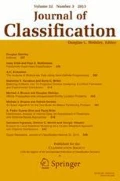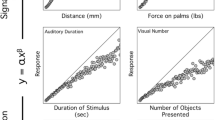Abstract
Five different methods for obtaining a rational initial estimate of the stimulus space in the INDSCAL model were compared using the SINDSCAL program for fitting INDSCAL. The effect of the number of stimuli, the number of subjects, the dimensionality, and the amount of error on the quality and efficiency of the final SINDSCAL solution were investigated in a Monte Carlo study. We found that the quality of the final solution was not affected by the choice of the initialization method, suggesting that SINDSCAL finds a global optimum regardless of the initialization method used. The most efficient procedures were the methods proposed by by de Leeuw and Pruzansky (1978) and by Flury and Gautschi (1986) for the simultaneous diagonalization of several positive definite symmetric matrices, and a method based on linearly constraining the stimulus space using the CANDELINC approach developed by Carroll, Pruzansky, and Kruskal (1980).
Similar content being viewed by others
References
ADDELMAN, S. (1962), “Orthogonal Main-Effect Plans for Asymmetrical Factorial Experiments,”Technometrics, 4, 21–46.
ARABIE, P., CARROLL, J. D., and DeSARBO, W. S. (1987),Three-Way Scaling and Clustering, Newbury Park: Sage.
CARROLL, J. D., and CHANG, J. J. (1969), “How to Use INDSCAL, a Computer Program for Canonical Decomposition ofN-Way Tables and Individual Differences in Multidimensional Scaling,” Unpublished report, AT&T Bell Laboratories, Murray Hill, NJ.
CARROLL, J. D., and CHANG, J. J. (1970), “Analysis of Individual Differences in Multidimensional Scaling via an N-Way Generalization of “Eckart-Young” decomposition,”Psychometrika, 35, 283–319.
CARROLL, J. D., and CHANG, J. J. (1972), “IDIOSCAL (IndividualDifferencesInOrientationSCALing): A Generalization of INDSCAL allowing forIDIOsyncratic Reference Systems as well as an Analytic Approximation to INDSCAL”, Paper presented at the Spring Meeting of the Psychometric Society, Princeton, NJ.
CARROLL, J. D., and PRUZANSKY, S. (1979), “USE of LINCINDS as a Rational Starting Configuration for INDSCAL,” Unpublished paper, AT&T Bell Laboratories, Murray Hill, NJ.
CARROLL, J. D., PRUZANSKY, S., and KRUSKAL, J. B. (1980), “CANDELING: A General Approach to Multidimensional Analysis of Many-way Arrays with Linear Constraints on Parameters,”Psychometrika, 45, 3–24.
CLARKSON, D. B. (1988), “A Remark on Algorithm AS 211. The F–G Diagonalization Algorithm,”Applied Statistics, 37, 147–151.
DAVISON, M. L. (1983),Multidimensional Scaling, New York: Wiley.
DE LEEUW, J., and PRUZANSKY, S. (1978), “A New Computational Method to Fit the Weighted Euclidean Distance Model,”Psychometrika, 43, 479–490.
FLURY, B. N. (1984), “Common Principal Components in k Groups,”Journal of the American Statistical Association, 78, 892–898.
FLURY, B. N., and CONSTANTINE, G. (1985), “Algorithm AS 211. The F–G Diagonalization Algorithm,”Applied Statistics, 34, 177–183.
FLURY, B. N., and GAUTSCHI, W. (1986), “An Algorithm for Simultaneous Orthogonal Transformation of Several Positive Definite Symmetric Matrices to Nearly Diagonal Form,”SIAM Journal on Scientific and Statistical Computing, 7, 169–184.
PRUZANSKY, S. (1975), “How to Use SINDSCAL. A Computer Program for Individual Differences in Multidimensional Scaling,” Unpublished paper, AT&T Bell Laboratories, Murray Hill, NJ.
RAMSAY, J. O. (1977), “Maximum Likelihood Estimation in Multidimensional Scaling,”Psychometrika, 42, 241–266.
SCHOENEMANN, P. H. (1972), “An Algebraic Solution for a Class of Subjective Metrics Models,”Psychometrika, 37, 441–451.
SCHOENEMANN, P. H., CARTER, F. S., and JAMES, W. L. (1976), “Contributions to Subjective Metrics Scaling: I. COSPA, a Fast Method for Fitting and Testing Horan's Model, and an Empirical Comparison with INDSCAL and ALSCAL,” Technical Report No. 587, Krannert Graduate School of Management, Purdue University, West Lafayette, IN.
SCHOENEMANN, P. H., JAMES, W. L., and CARTER, F. S. (1978), “COSPA: Common Space Analysis — a Program for Fitting and Testing Horan's Subjective Metrics Model,”Journal of Marketing Research, 15, 268–272.
TAKANE, Y., YOUNG, F. W., and DE LEEUW, J. (1977), “Nonmetric Individual Differences Multidimensional Scaling: An Alternating Least Squares Method with Optimal Scaling Features,”Psychometrika, 42, 7–67.
TUCKER, L. R (1966), “Some Mathematical Notes on Three-Mode Factor Analysis,”Psychometrika, 31, 279–311.
Author information
Authors and Affiliations
Additional information
Geert De Soete is supported as “Bevoegdverklaard Navorser” of the Belgian “Nationaal Fonds voor Wetenschappelijk Onderzoek.” The authors gratefully acknowledge the helpful comments and suggestions of the reviewers.
Rights and permissions
About this article
Cite this article
Carroll, J.D., De Soete, G. & Pruzansky, S. An evaluation of five algorithms for generating an initial configuration for SINDSCAL. Journal of Classification 6, 105–119 (1989). https://doi.org/10.1007/BF01908591
Issue Date:
DOI: https://doi.org/10.1007/BF01908591




